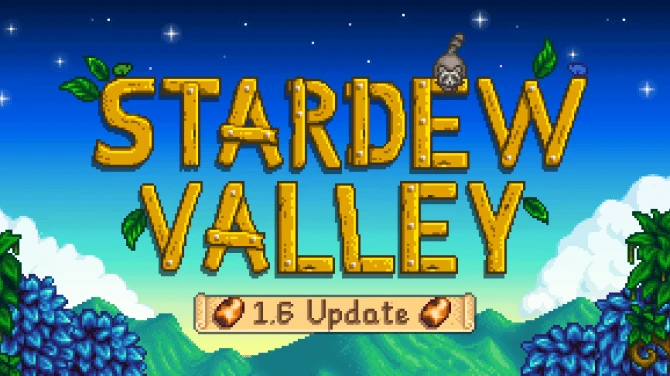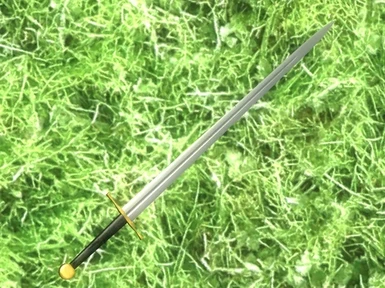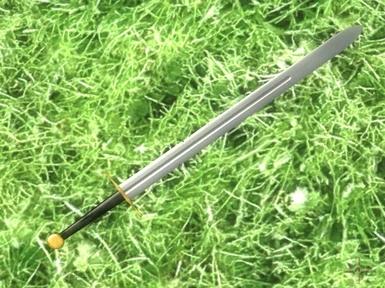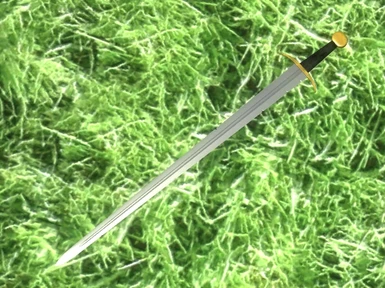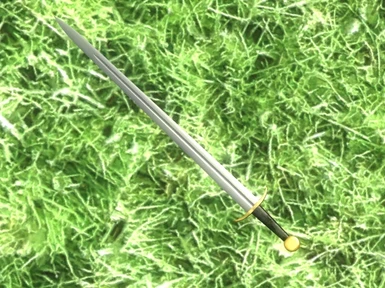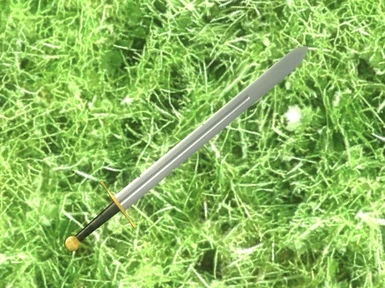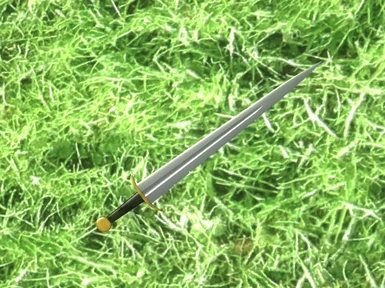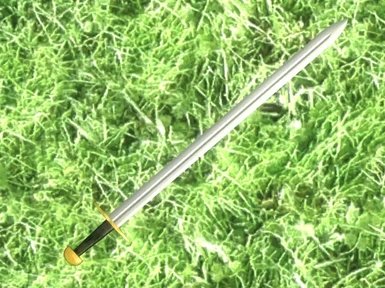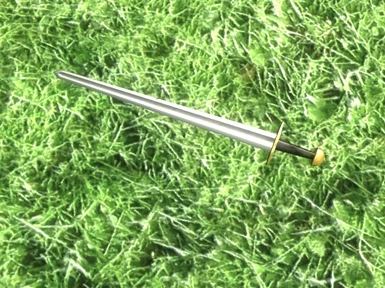About this mod
Oakeshott types X, XI, XII, XIIa, XIII, XIIIa, XIV, and XVIIId
- Permissions and credits
WHAT IT DOES
It adds a couple of authentic broadswords from the European High Middle Ages, because, hey, it's medieval out there ;)
The weapons roughly equal Bethesda's similar iron weapons in weight, for balance reasons, but are similar to the equivalent non-unique Daedric weapons in damage and speed. They also ignore resistances just like daedric or silver weapons. I.e., they ARE powerful, but not much more so than fairly ordinary stuff you'd find at high levels.
All stated types are the Oakeshott sword types, in as much as I can judge what type a sword is. Bear in mind though that swords were not made identical, and there was no such thing as buying a "Type X" sword at the time. There were thousands of smiths across a whole continent and across several centuries, and pretty much infinite variation in the swords they produced. So if my Type X is half an inch shorter than your Type X, well, please bear with me.
The blades are made of pattern-welded steel, a.k.a., folded steel, hence the pattern. A few were even made of imported Damascus steel, but most of the good swords were just folded steel. It was actually quite popular back then. E.g., the mention of a "wave sword" in Beowulf is thought to refer to the wavy pattern of folded steel.
They all have their fair share of nicks in the edge though, because they're weapons used in battle.
The hilts have dirty-ish black leather on the grip, and tarnished but shiny yellow metal on the cross and pommel. Take your pick between brass, bronze or gold-plated steel. While we don't have examples of brass hilts from the middle ages (but we do from the Renaissance), there are examples of "fire gilt" gold-plating on the hilts of swords made for nobles and kings. There is also evidence of yellow metal on hilts in contemporary art, but we do not know if it was supposed to be brass, bronze or gold.
All swords have custom scabbards that exactly fit the shape of the blade. They're covered in leather, as was the case for most medieval scabbards, and have the same yellow metal on the metal parts (e.g., the chape) as the hilts. I.e., when sheathed, the scabbard should match the hilt.
The swords are:
1. Type X: Cutting sword, with a mediocre tip, very similar to the earlier Viking swords. It is very broad, with a wide and shallow fuller. This blade is about 30 inches long and a whole 2.4 inches wide at the base, but tapers to about half that before starting to converge into a tip.
2. Type XI: It is more slender, with parallel edges, and a better tip. It has a blade about 36 inches long (these were cavalry swords) and 1.8 inches wide for most of its length.
3. Type XII: Another tapering sword, although not as acutely as the later Type XIV, and with a very good piercing tip. It has a blade about 32.5 inches long. It starts 2.1 inch at the hilt, but it tapers visibly from there. The fuller is long for this type, but not ahistorical.
4. Type XIII: The Type XIII is not a continuation of Type XII, but a parallel evolution, with a different philosophy in mind. While the Type XII was evolving in the direction of becoming better at piercing, the Type XIII essentially allowed harder hits with the edge, by having a hilt long enough to allow using a second hand on the pommel if needed. I.e., these are the first hand-and-half swords. This particular example has a 2.25 wide blade for most of its length, and about 32.5 inch long, and with a fairly typical fuller length for this type.
5. Type XIV: Flat blade that starts a whole 3 inch broad, but tapers strongly right from the hilt, to a very sharp tip. About 27-2/3 inches long. The single fuller is somewhat on the long side for this type, but it's still in the very historical range.
BONUS SWORDS
Of these, one is not high medieval and two of them are not qualifying as arming swords, on account of being two-handed. Still, I couldn't be bothered making a new mod for them, and I wanted to keep the name of the mod the same as the Fallout New Vegas version, so I'm including them here. If they bother you, just don't use them.
6. Type XVIIId: this is kinda the mean, late medieval grandson of the Type XIV. Diamond-section blade about 35.5 inches long. It starts 2.1 inch at the hilt, but it tapers visibly from there to a nasty tip. Unlike the other Type XVIII variants, the XVIIId has a long fuller, going almost all the length of the blade. This blade is actually very slightly convex, but still mostly a diamond section blade.
7. Type XIIa: It's basically the Type XII with a 38-7/8 inch blade and a proper two-handed grip. These are early two-handed swords, of the improved piercing variety.
8. Type XIIIa: It's basically the Type XIII with a 38-7/8 inch blade and a proper two-handed grip. These are early two-handed swords, of the improved cutting variety.
RETEXTURING AND MODDING
As most of my mods, it's designed for ease of retexturing, so the textures are separate pieces, and the mapping such that you can just swap in some other material. Essentially, if you have any other photo of a metal surface, as long as it's a power of 2 in pixels for width and height (256, 512, 1024, 2048 or 4096), you can just swap it in and have a blade in the metal of your choice. Ditto for the cross. So if you want a rusty blade or a copper cross or whatever, you can help yourself.
The mesh pieces are separate too, somewhat like in Neverwinter Nights 2, so if you're not affraid to copy nodes around in NifSkope, you can mix and match. Think of them as Lego swords, basically ;)
HOW TO GET IT
Olfand in Nordwinds in Bruma sells these. They're not the cheapest swords around, but quality smithing comes at a price.
Or if you're the sneaky and unchivalrous kind, you can look for the crate in his shop and just steal them. The crate is right on your right as you enter the shop. Presumably, he just received them from someone else, since he's not a swordsmith himself. It'll be locked, but it's a very easy lock.
HOW TO INSTALL IT
Search for "set bInvalidateOlderFiles=0" in your Oblivion.ini file and change it to "set bInvalidateOlderFiles=1", if you haven't done so already.
Extract the archive, with directories, in your "Oblivion\Data" folder. Select it in the list of plugin files in the launcher.
HOW TO UNINSTALL IT
Delete the .esp file from your Data directory.
Delete the MArmingSword directory in both the Meshes\Weapons and Textures\Weapons directories.
CONFLICTS
It shouldn't conflict with anything.
LICENSE
I release it in the public domain. You can do anything you wish with it. I would, of course, appreciate it if you give credit, but if not, so be it, I can live with that too.
VERSION HISTORY
1.05:
Fixed the weapon sizes, since I had grossly miscalculated the conversion from inches to game units and they were much too small
Made the grips and pommels a little bit thicker
1.04:
Fixed the screwed-up UV mapping on the Type XIII scabbard
1.03:
First Oblivion release
It adds a couple of authentic broadswords from the European High Middle Ages, because, hey, it's medieval out there ;)
The weapons roughly equal Bethesda's similar iron weapons in weight, for balance reasons, but are similar to the equivalent non-unique Daedric weapons in damage and speed. They also ignore resistances just like daedric or silver weapons. I.e., they ARE powerful, but not much more so than fairly ordinary stuff you'd find at high levels.
All stated types are the Oakeshott sword types, in as much as I can judge what type a sword is. Bear in mind though that swords were not made identical, and there was no such thing as buying a "Type X" sword at the time. There were thousands of smiths across a whole continent and across several centuries, and pretty much infinite variation in the swords they produced. So if my Type X is half an inch shorter than your Type X, well, please bear with me.
The blades are made of pattern-welded steel, a.k.a., folded steel, hence the pattern. A few were even made of imported Damascus steel, but most of the good swords were just folded steel. It was actually quite popular back then. E.g., the mention of a "wave sword" in Beowulf is thought to refer to the wavy pattern of folded steel.
They all have their fair share of nicks in the edge though, because they're weapons used in battle.
The hilts have dirty-ish black leather on the grip, and tarnished but shiny yellow metal on the cross and pommel. Take your pick between brass, bronze or gold-plated steel. While we don't have examples of brass hilts from the middle ages (but we do from the Renaissance), there are examples of "fire gilt" gold-plating on the hilts of swords made for nobles and kings. There is also evidence of yellow metal on hilts in contemporary art, but we do not know if it was supposed to be brass, bronze or gold.
All swords have custom scabbards that exactly fit the shape of the blade. They're covered in leather, as was the case for most medieval scabbards, and have the same yellow metal on the metal parts (e.g., the chape) as the hilts. I.e., when sheathed, the scabbard should match the hilt.
The swords are:
1. Type X: Cutting sword, with a mediocre tip, very similar to the earlier Viking swords. It is very broad, with a wide and shallow fuller. This blade is about 30 inches long and a whole 2.4 inches wide at the base, but tapers to about half that before starting to converge into a tip.
2. Type XI: It is more slender, with parallel edges, and a better tip. It has a blade about 36 inches long (these were cavalry swords) and 1.8 inches wide for most of its length.
3. Type XII: Another tapering sword, although not as acutely as the later Type XIV, and with a very good piercing tip. It has a blade about 32.5 inches long. It starts 2.1 inch at the hilt, but it tapers visibly from there. The fuller is long for this type, but not ahistorical.
4. Type XIII: The Type XIII is not a continuation of Type XII, but a parallel evolution, with a different philosophy in mind. While the Type XII was evolving in the direction of becoming better at piercing, the Type XIII essentially allowed harder hits with the edge, by having a hilt long enough to allow using a second hand on the pommel if needed. I.e., these are the first hand-and-half swords. This particular example has a 2.25 wide blade for most of its length, and about 32.5 inch long, and with a fairly typical fuller length for this type.
5. Type XIV: Flat blade that starts a whole 3 inch broad, but tapers strongly right from the hilt, to a very sharp tip. About 27-2/3 inches long. The single fuller is somewhat on the long side for this type, but it's still in the very historical range.
BONUS SWORDS
Of these, one is not high medieval and two of them are not qualifying as arming swords, on account of being two-handed. Still, I couldn't be bothered making a new mod for them, and I wanted to keep the name of the mod the same as the Fallout New Vegas version, so I'm including them here. If they bother you, just don't use them.
6. Type XVIIId: this is kinda the mean, late medieval grandson of the Type XIV. Diamond-section blade about 35.5 inches long. It starts 2.1 inch at the hilt, but it tapers visibly from there to a nasty tip. Unlike the other Type XVIII variants, the XVIIId has a long fuller, going almost all the length of the blade. This blade is actually very slightly convex, but still mostly a diamond section blade.
7. Type XIIa: It's basically the Type XII with a 38-7/8 inch blade and a proper two-handed grip. These are early two-handed swords, of the improved piercing variety.
8. Type XIIIa: It's basically the Type XIII with a 38-7/8 inch blade and a proper two-handed grip. These are early two-handed swords, of the improved cutting variety.
RETEXTURING AND MODDING
As most of my mods, it's designed for ease of retexturing, so the textures are separate pieces, and the mapping such that you can just swap in some other material. Essentially, if you have any other photo of a metal surface, as long as it's a power of 2 in pixels for width and height (256, 512, 1024, 2048 or 4096), you can just swap it in and have a blade in the metal of your choice. Ditto for the cross. So if you want a rusty blade or a copper cross or whatever, you can help yourself.
The mesh pieces are separate too, somewhat like in Neverwinter Nights 2, so if you're not affraid to copy nodes around in NifSkope, you can mix and match. Think of them as Lego swords, basically ;)
HOW TO GET IT
Olfand in Nordwinds in Bruma sells these. They're not the cheapest swords around, but quality smithing comes at a price.
Or if you're the sneaky and unchivalrous kind, you can look for the crate in his shop and just steal them. The crate is right on your right as you enter the shop. Presumably, he just received them from someone else, since he's not a swordsmith himself. It'll be locked, but it's a very easy lock.
HOW TO INSTALL IT
Search for "set bInvalidateOlderFiles=0" in your Oblivion.ini file and change it to "set bInvalidateOlderFiles=1", if you haven't done so already.
Extract the archive, with directories, in your "Oblivion\Data" folder. Select it in the list of plugin files in the launcher.
HOW TO UNINSTALL IT
Delete the .esp file from your Data directory.
Delete the MArmingSword directory in both the Meshes\Weapons and Textures\Weapons directories.
CONFLICTS
It shouldn't conflict with anything.
LICENSE
I release it in the public domain. You can do anything you wish with it. I would, of course, appreciate it if you give credit, but if not, so be it, I can live with that too.
VERSION HISTORY
1.05:
Fixed the weapon sizes, since I had grossly miscalculated the conversion from inches to game units and they were much too small
Made the grips and pommels a little bit thicker
1.04:
Fixed the screwed-up UV mapping on the Type XIII scabbard
1.03:
First Oblivion release







